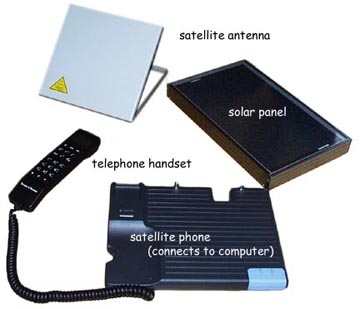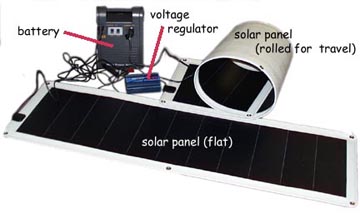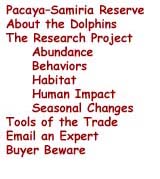

How does the VE team run its computers, telephone, video cameras and other modern tools in a remote area where there is no electricity?
In this day of laptop computers and cell phones, most people think that we can just use lots and lots of batteries. Batteries need to be recharged, however, so we would have to take hundreds of pounds of batteries to meet our needs. Batteries are also very expensive (a three-hour computer battery costs about $200!), so this is not a practical solution for us either. So, we need to find a source of energy that is plentiful, cheap and efficient. Solar energy is a perfect solution of

the Virtual Explorers. Because the area we are studying is just about seven degrees south of the equator, we have twelve hours of sun each day. Solar energy can be collected passively, which means that once we set our system up, we don't have to do any more work. The electricity will make itself. If it rains, we can start collecting energy again as soon as the rain stops. We only need enough light to cast a shadow to collect energy.
How we do it.
We purchased three solar panels that are specially made to not only collect solar energy, but to intensify the power of the sunlight that hits the panels. The panels are placed on top of a platform we had built for them on the top deck of the boat. Twine is tied through the rivet holes on the edges of the panels so that the panels lie flat and do not blow away if there is a strong wind. Two of the solar panels are joined together by the electrical wires that lead out of the panels. The electricity gathered in the panels is transferred through the wires to a 12-volt battery. (This is the battery size that is used in most cars.) The third panel is hooked up to its own battery as a back up power source. Collecting solar energy is that easy. However, we have to get energy from the battery to our electronic devices. We can't just plug a computer into the battery, because the energy is too powerful and will wreck our equipment.
DC or AC?
The electricity stored in the battery is DC, or direct current. Direct current was the first means from which people used stored electricity. People soon found, though, that direct current is dangerous. Not only is it a fire hazard, but people who touch live direct current wires may be easily electrocuted. Many countries have converted to alternating current, known as AC.

How much energy can be collected from the sun?
The sun gives off the equivalent of 1000 watts (one kilowatt) of electricity per square meter at noon on a clear day at sea level. Under these conditions, the panels collect "full sun." Even though a lot of energy from the sun is available, a cloudy sky, water vapor, the boat moving into an area shaded by trees, or even the amount of dust in the air or on the solar panels can affect the amount of solar energy we can collect. It is not yet possible to collect 100 percent of the energy available from the sun and turn it into electricity. The best solar panels will only collect between 11 and 15 percent of the energy available from the sun as its rays hit the earth. We estimate that two solar panels will allow us to collect enough energy in the 12-volt battery to run our laptops for about six hours a day. We also have an additional battery and a solar panel as a back up for cloudy days or to recharge camera batteries in an emergency.
Do solar panels need a lot of maintenance?
Once we set up the solar panels on the platform on the top of the boat tie them down through the rivets and plug the wires into the battery, there is little to do except "collect" our electricity. We should keep the panels clean so that they can collect the maximum amount of energy. Unless we have some birds that fly over and leave us a "gift," we probably won't have to touch the panels until we are ready to roll them up and take them home.




